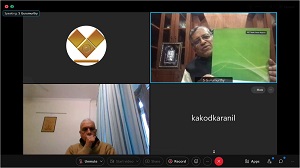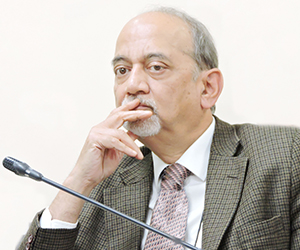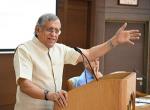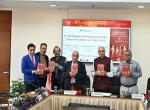Shri Gurumurthy Ji, Chairman VIF made a virtual release of the Interim Report of the VIF Task Force on “India’s Energy Transition in a Carbon-Constrained World: The Role of Nuclear Power” at a function hosted by the Vivekananda International Foundation (VIF) on 4th January 2022.
The programmr began with opening remarks by Dr. Arvind Gupta, Director of VIF. He acknowledged the concern of climate change and the subsequent challenge for India to transition into a low carbon economy. Highlighting the need for diversification of energy sources whilst being mindful of developmental prerogatives, he credited the project Task Force for undertaking a study that explores technology options and financing mechanisms available in order to make this transition and examines the role of nuclear power as a stable base-load, low carbon source to aid this transition.
Shri DS Choudhary, Director, Operations of the NPCIL, then spoke about the efforts of the NPCIL in scaling up the current nuclear capacity of India, the progress in getting 700 reactors connected to the grid, and how these have been a fruit of over a decade long commitment to research and initiatives by the DEA and NPCIL, especially pulling through when the nuclear sector was facing sanctions.
The Interim Report was then released by Shri S Gurumurthy, Chairman, VIF. This was followed by a power-point presentation by Ambassador DP Srivastava, coordinator of the VIF NPCIL project. The presentation laid emphasis on the following points:
a. A comparison of country-wise carbon emission levels and historical responsibility since 1751. India with cumulative emissions bears no responsibility for climate change with cumulative CO2 emissions of 48 billion tons. In contrast, the US has emitted 399 billion tons CO2, EU 353 billion tons, and China 200 billion tons.
b. China has a disproportionate share in the global carbon budget. It emitted 10.17 billion tons of CO2 in 2019 accounting for 20% of the global emissions. Its relative share in the global carbon budget will increase to around 30 % by 2030.
c. Impact of integration of renewables explaining that balancing costs and grid costs are not part of the renewable tariff structure in India and have to be absorbed by DISCOMS.
d. The intermittent nature of renewables requires balancing power when the sun is not shining and the wind is not blowing. This pushes up their cost which is eventually passed on to the consumer.
e. Studies by the MIT and OECD have shown that unless nuclear power is included in the generationmix, the costs of achieving deep decarbonization increase significantly.
f. Comparison of emission levels of various technologies reveals that nuclear has the least share with approximately 5.1–6.4 g CO2 eq./kWh.
The presentation ended with the recommendations that Nuclear is the only emission-free source of stable, base-load power. Ramping it up will require government support. An immediate step will be providing it a must-run status on par with renewables.
Dr. Anil Kakodkar, former chairman of the Atomic Energy Commission and Secretary, Department of Atomic Energy in his address stressed that the move towards a green economy requires increasing the share of electricity in the energy mix from around 20 percent now to 35 percent and eventually 80 percent. An increase in green power at this scale is not possible by relying exclusively on renewables. It is only nuclear power, which can supply emission-free energy at this scale. As MIT and OECD studies have pointed out, the inclusion of nuclear power in the generationmix will also help optimize the cost of transition to a low carboneconomy. He also explained that for the same amount of electricity generated, the capital cost of nuclear power is less than that of renewables. Besides, the cost of setting up a nuclear power plant in India is nearly half the cost of setting up a plant of comparable capacity in western countries.
Shri S. Gurumurthy Ji in his address outlined the importance of nuclear power. He said that until the 60s, energy was part of the discourse on international trade. In the 70s, this was transformed into a geo-economic and geo-political issue. Thereafter, energy became enmeshed in the security debate. Today, it is linked to climate change. He congratulated the Task Force for a well-researched report that helps explore India’s energy transition options. He stressed that a public education campaign is needed to help mobilize public opinion in favor of nuclear power. He pointed out that India with 1/6th of the world population supports 7-8 percent of bio-diversity despite having only 2 percent of the world land-mass. This is only possible due to our eco-friendly philosophy and belief in the unity of man and nature. The lifestyle choices, including dietary habits of developed countries and Abrahamic cultures, encourage excessive energy consumption, and demand on scarce land and water resources. He stated that in order to meet the challenge of climate change, we must address not only the supply side, but also the demand side of the equation. This requires a more eco-centric way of life. This aspect has to be included in the agenda of the climate debate.








Post new comment